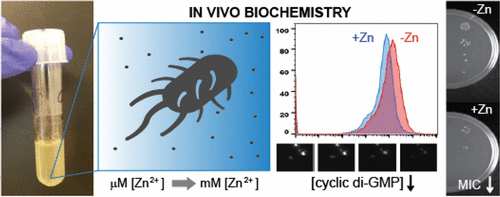当前位置:
X-MOL 学术
›
Biochemistry
›
论文详情
Our official English website, www.x-mol.net, welcomes your feedback! (Note: you will need to create a separate account there.)
In Vivo Biochemistry: Single-Cell Dynamics of Cyclic Di-GMP in Escherichia coli in Response to Zinc Overload
Biochemistry ( IF 2.9 ) Pub Date : 2017-11-02 00:00:00 , DOI: 10.1021/acs.biochem.7b00696 Jongchan Yeo 1 , Andrew B. Dippel 1 , Xin C. Wang 2 , Ming C. Hammond 1, 2
Biochemistry ( IF 2.9 ) Pub Date : 2017-11-02 00:00:00 , DOI: 10.1021/acs.biochem.7b00696 Jongchan Yeo 1 , Andrew B. Dippel 1 , Xin C. Wang 2 , Ming C. Hammond 1, 2
Affiliation

|
Intracellular signaling enzymes drive critical changes in cellular physiology and gene expression, but their endogenous activities in vivo remain highly challenging to study in real time and for individual cells. Here we show that flow cytometry can be performed in complex media to monitor single-cell population distributions and dynamics of cyclic di-GMP signaling, which controls the bacterial colonization program. These in vivo biochemistry experiments are enabled by our second-generation RNA-based fluorescent (RBF) biosensors, which exhibit high fluorescence turn-on in response to cyclic di-GMP. Specifically, we demonstrate that intracellular levels of cyclic di-GMP in Escherichia coli are repressed with excess zinc, but not with other divalent metals. Furthermore, in both flow cytometry and fluorescence microscopy setups, we monitor the dynamic increase in cellular cyclic di-GMP levels upon zinc depletion and show that this response is due to de-repression of the endogenous diguanylate cyclase DgcZ. In the presence of zinc, cells exhibit enhanced cell motility and increased sensitivity to antibiotics due to inhibited biofilm formation. Taken together, these results showcase the application of RBF biosensors in visualizing single-cell dynamic changes in cyclic di-GMP signaling in direct response to environmental cues such as zinc and highlight our ability to assess whether observed phenotypes are related to specific signaling enzymes and pathways.
中文翻译:

体内生物化学:响应锌超载的大肠杆菌中的循环双GMP的单细胞动力学。
细胞内信号转导酶驱动细胞生理和基因表达的关键变化,但它们的体内内源性活性对于实时研究以及对单个细胞的研究仍然具有很高的挑战性。在这里,我们显示可以在复杂的培养基中进行流式细胞术,以监测单细胞种群分布和控制细菌定殖程序的循环双GMP信号的动态。这些体内生物化学实验是通过我们的第二代基于RNA的荧光(RBF)生物传感器实现的,该传感器响应循环di-GMP表现出高荧光开启。具体来说,我们证明了在大肠杆菌中细胞内水平的环状di-GMP被过量的锌所抑制,但未被其他二价金属所抑制。此外,在流式细胞仪和荧光显微镜设置中,我们监测锌耗尽后细胞循环中di-GMP水平的动态增加,并表明该反应是由于内源性双鸟苷酸环化酶DgcZ的抑制所致。在锌的存在下,由于抑制了生物膜的形成,细胞表现出增强的细胞运动性和对抗生素的敏感性。综上所述,这些结果展示了RBF生物传感器在可视化直接响应环境信号(例如锌)的循环di-GMP信号中单细胞动态变化中的应用,并突出了我们评估观察到的表型是否与特定信号酶和途径相关的能力。 。
更新日期:2017-11-02
中文翻译:

体内生物化学:响应锌超载的大肠杆菌中的循环双GMP的单细胞动力学。
细胞内信号转导酶驱动细胞生理和基因表达的关键变化,但它们的体内内源性活性对于实时研究以及对单个细胞的研究仍然具有很高的挑战性。在这里,我们显示可以在复杂的培养基中进行流式细胞术,以监测单细胞种群分布和控制细菌定殖程序的循环双GMP信号的动态。这些体内生物化学实验是通过我们的第二代基于RNA的荧光(RBF)生物传感器实现的,该传感器响应循环di-GMP表现出高荧光开启。具体来说,我们证明了在大肠杆菌中细胞内水平的环状di-GMP被过量的锌所抑制,但未被其他二价金属所抑制。此外,在流式细胞仪和荧光显微镜设置中,我们监测锌耗尽后细胞循环中di-GMP水平的动态增加,并表明该反应是由于内源性双鸟苷酸环化酶DgcZ的抑制所致。在锌的存在下,由于抑制了生物膜的形成,细胞表现出增强的细胞运动性和对抗生素的敏感性。综上所述,这些结果展示了RBF生物传感器在可视化直接响应环境信号(例如锌)的循环di-GMP信号中单细胞动态变化中的应用,并突出了我们评估观察到的表型是否与特定信号酶和途径相关的能力。 。


























 京公网安备 11010802027423号
京公网安备 11010802027423号